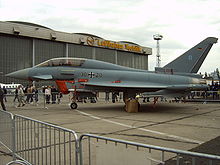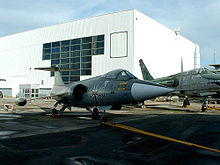- Bundeswehr
-
"Military of Germany" redirects here. For other uses, see Military of Germany (disambiguation).
Federal Defence Forces of Germany
Bundeswehr
Insignia of the BundeswehrFounded November 12, 1955 Current form October 2, 1990 Service branches Heer (Army)
Marine (Navy)
Luftwaffe (Air Force)
Streitkräftebasis (Joint Support Service)
Zentraler Sanitätsdienst (Central Medical Services)Headquarters Bonn, Berlin and Potsdam Leadership Commander-in-Chief Defence Minister Thomas de Maizière [1]
after declaration of state of defence: Chancellor Angela Merkel [2]Minister of Defense Thomas de Maizière Chief of staff General Volker Wieker (Heer) Manpower Military age 17 Conscription No (Suspended on 1 July 2011) Available for
military service19,594,118 (2009 est.), age 17–49 Fit for
military service15,747,493 (2009 est.), age 17–49 Reaching military
age annually445,048 (2009 est.) Active personnel 220,000 regulars Reserve personnel c. 355,000 regular reserve Expenditures Budget € 31.1 billion (FY09) Percent of GDP 1.5% (FY09) Industry Domestic suppliers EADS
Heckler & Koch
Rheinmetall
Krauss-Maffei Wegmann
Howaldtswerke-Deutsche Werft
Walther arms
ThyssenKruppForeign suppliers  European Union
European Union
 United States
United States
 Israel
IsraelAnnual imports Volume of about $1 bln (2009 est.) Annual exports Volume of about $9 bln (2009 est.) The Bundeswehr (German for "Federal Defence Force";
 armed forces of Germany and their civil administration and procurement authorities. The States of Germany are not allowed to maintain armed forces of their own, since the German Constitution states that matters of defense fall into the sole responsibility of the federal government.[3]
armed forces of Germany and their civil administration and procurement authorities. The States of Germany are not allowed to maintain armed forces of their own, since the German Constitution states that matters of defense fall into the sole responsibility of the federal government.[3]The Bundeswehr is divided into a military part (armed forces or Streitkräfte) and a civil part with the armed forces administration (Wehrverwaltung), the federal bureau of procurement (Bundesamt für Wehrtechnik und Beschaffung) and the federal bureau for information management and information technology of the Bundeswehr (Bundesamt für Informationsmanagement und Informationstechnik der Bundeswehr, sometimes abbreviated as IT-AmtBw). The military part of the federal defense force consists of Army (Heer), Navy (Marine), Air Force (Luftwaffe), Joint Support Service (Streitkräftebasis), and Central Medical Services (Zentraler Sanitätsdienst) branches.
By international agreement, the Bundeswehr may not exceed an active strength of 370,000. The Bundeswehr currently has 247,100 active troops.[dated info] Of these, 188,112 are professional soldiers, 25,566 18–25-year-old conscripts,[dated info] who used to serve for at least six months,[4] until conscription was ended in January 2011, and 33,417 Volunteer conscripts serving a longer military service.[5][dead link] In addition the Bundeswehr has approximately 350,000 reserve personnel.[citation needed]
Women have served in the medical service since 1975. From 1993 to 2000, they were also allowed to serve as enlisted personnel and non-commissioned officers in the medical service and the army bands. In 2000, in a lawsuit brought up by Tanja Kreil, the European Court of Justice issued a ruling allowing women to serve in more roles than previously allowed. Since 2001 they can serve in all functions of service without restriction, but they were not subject to conscription. There are presently around 14,500 women on active duty and a number of female reservists who take part in all duties including peacekeeping missions and other operations.[citation needed] In 1994, Verena von Weymarn became Generalarzt der Luftwaffe ("Surgeon General of the Air Force"), the first woman ever to reach the rank of general in the armed forces of Germany.
Contents
History
Main article: Military history of GermanyThe Cold War period 1955–1990
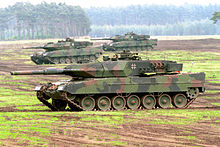 Leopard 2 tanks
Leopard 2 tanks
After World War II the responsibility for the security of Germany as a whole rested with the four Allied Powers: the United States, the United Kingdom, France and the Soviet Union. Germany had been without armed forces since the Wehrmacht was dissolved following World War II. When the Federal Republic of Germany was founded in 1949, it was without a military. Germany remained completely demilitarized and any plans for a German military were forbidden by Allied regulations. Only some naval mine-sweeping units had continued to exist, but unarmed, under Allied control, and not as a national defence force. Even the Border guards was only established in 1951.
There was a discussion between the United States, the United Kingdom and France over the issue of a revived (West) German military. In particular, France was reluctant to allow Germany to rearm in light of recent history (Germany had invaded France twice in living memory, in World War I and World War II, and also defeated France in the Franco-German War of 1870/71; (see also French–German enmity)). However, after the project for a European Defence Community failed in the French National Assembly in 1954, France agreed to West German accession to NATO and rearmament.
With growing tensions between the Soviet Union and the West, especially after the Korean War, this policy was to be revised. While the German Democratic Republic (East Germany) was already secretly rearming, the seeds of a new West German force started in 1950 when former high-ranking German officers were tasked by Chancellor Konrad Adenauer to discuss the options for West German rearmament. The results of a meeting in the monastery of Himmerod formed the conceptual base to build the new armed forces in West Germany. The Amt Blank (Blank Agency, named after its director Theodor Blank), the predecessor of the later Federal Ministry of Defense, was formed the same year to prepare the establishment of the future forces. Hasso von Manteuffel, a former general of the Wehrmacht and liberal politician, submitted the name Bundeswehr for the new forces. This name was later confirmed by the West German Bundestag.
The Bundeswehr was officially established on the 200th birthday of Scharnhorst on 12 November 1955. In personnel and education terms, the most important initial feature of the new German armed forces was to be their orientation as citizen defenders of a democratic state, fully subordinate to the political leadership of the country.[6] A personnel screening committee was created to make sure that the future colonels and generals of the armed forces were those whose political attitude and experience would be acceptable to the new democratic state.[7] There were a few key reformers, such as General Ulrich de Maiziere, General Graf von Kielmansegg, and Graf von Baudissin,[8] who reemphasised some of the more democratic parts of Germany’s armed forces history in order to establish a solid civil-military basis to build upon.
After an amendment of the Basic Law in 1955, West Germany became a member of NATO. The first public military review took place at Andernach, in January 1956.[9] A US Military Assistance Advisory Group (MAAG) helped with the introduction of the Bundeswehr's initial equipment and war material, predominantly of American origin.[citation needed] In 1956, conscription for all men between the ages of 18 and 45 was reintroduced, later augmented by a civil alternative with longer duration (see Conscription in Germany). In response, East Germany formed its own military force, the Nationale Volksarmee (NVA), in 1956, with conscription being established only in 1962. The Nationale Volksarmee was eventually dissolved with the reunification of Germany in 1990. Compulsory conscription was finally ended in January 2011.
During the Cold War the Bundeswehr was the backbone of NATO's conventional defense in Central Europe. It had a strength of 495,000 military and 170,000 civilian personnel. The Army consisted of three corps with 12 divisions, most of them heavily armed with tanks and APCs. The Luftwaffe owned significant numbers of tactical combat aircraft and took part in NATO's integrated air defense (NATINAD). The Navy was tasked and equipped to defend the Baltic Approaches, to provide escort reinforcement and resupply shipping in the North Sea and to contain the Soviet Baltic Fleet.
During this time the Bundeswehr did not take part in combat operations. However there were a number of large-scale training and operational casualties. The first such incident was in June 1957, when fifteen paratroop recruits were drowned in the Iller river, Bavaria.[10]
German Reunification 1990
After reunification of Germany in 1990, the Bundeswehr was reduced to 370,000 military personnel in accordance with the Treaty on the Final Settlement with Respect to Germany between the two German governments and the Allies (2+4 Treaty). The former East German Nationale Volksarmee (NVA) was disbanded, with a portion of its personnel and material being absorbed into the Bundeswehr.
 The Bundeswehr was the first NATO-member to use the Soviet-built MiG 29 jet, taken over from the former East German Air Force.
The Bundeswehr was the first NATO-member to use the Soviet-built MiG 29 jet, taken over from the former East German Air Force.
About 50,000 Volksarmee personnel were integrated into the Bundeswehr on 2 October 1990. This figure was rapidly reduced as conscripts and short-term volunteers completed their service. A number of senior officers (but no generals or admirals) received limited contracts for up to two years to continue daily operations. Personnel remaining in the Bundeswehr were awarded new contracts and new ranks, dependent on their individual qualification and experience. Many received and accepted a lower rank than previously held in the Volksarmee.
In general, the unification process of the two militaries—under the slogan "Armee der Einheit" (or "Army of Unity")—has been seen publicly as a major success and an example for other parts of the society.
With the reduction, a large amount of the military hardware of the Bundeswehr, as well as of the Volksarmee, had to be disposed of. Most of the armored vehicles and fighter jet aircraft were dismantled under international disarmament procedures. Many ships were scrapped or sold, often to the Baltic states or Indonesia (the latter received 39 former Volksmarine vessels of various types).
Mission
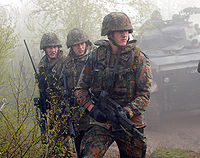 German Army soldiers in Bosnia
German Army soldiers in Bosnia
The role of the Bundeswehr is described in the Constitution of Germany (Art. 87a) as absolutely defensive only. Its only active role before 1990 was the Katastropheneinsatz (disaster control). Within the Bundeswehr, it helped after natural disasters both in Germany and abroad. After 1990, the international situation changed from East-West confrontation to one of general uncertainty and instability. Today, after a ruling of the Federal Constitutional Court in 1994 the term "defense" has been defined to not only include protection of the borders of Germany, but also crisis reaction and conflict prevention, or more broadly as guarding the security of Germany anywhere in the world. According to the definition given by former Defense Minister Struck, it may be necessary to defend Germany even at the Hindu Kush. This requires the Bundeswehr to take part in operations outside of the borders of Germany, as part of NATO or the European Union and mandated by the UN.
Organization and command structure
 A German Navy Frigate
A German Navy Frigate
With the growing number of missions abroad it was recognized that the Bundeswehr required a totally new command structure. A reform commission under the chairmanship of the former President Richard von Weizsäcker presented its recommendations in spring 2000.
In October 2000 the Joint Support Service, the Streitkräftebasis, was established to concentrate logistics and other supporting functions such as military police, supply and communications under one command. Medical support was reorganized with the establishment of the Central Medical Services.
The combat forces of the Army are organized into five combat divisions and participate in multi-national command structures at the corps level. The Air Force maintains three divisions and the Navy is structured into two flotillas. The Joint Support Service and the Central Medical Services are both organized in four regional commands of identical structure. All of these services also have general commands for training, procurement, and other general issues.
The minister of defense or the chancellor is supported by the Chief of Defense (CHOD, Generalinspekteur) and the service chiefs (Inspekteure) and their respective staffs in his or her function as commander-in-chief. The CHOD and the service chiefs form the Military Command Council (Militärischer Führungsrat) with functions similar to those of the Joint Chiefs of Staff in the United States. Subordinate to the CHOD is the Armed Forces Operational Command (Einsatzführungskommando). For smaller missions one of the service HQs (e.g. the Fleet Command) may exercise command and control of forces in missions abroad. The Bundestag must approve any deployment abroad by a simple majority. This has led to some discontent with Germany's allies about troop deployments e.g. in Afghanistan since parliamentary consent over such issues is relatively hard to achieve in Germany.
The Bundeswehr in general is still among the world's most technologically advanced and best-supplied militaries, as befits Germany's overall economic prosperity and infrastructure. Its budget is, however, steadily shrinking and among the lowest military budgets in NATO in terms of share of GDP.
Operations
 A German infantryman stands at the ready with his Heckler & Koch G36 during a practice exercise in 2004. US troops watch in the background. All rifles in the photo are equipped with blank firing adapters.
A German infantryman stands at the ready with his Heckler & Koch G36 during a practice exercise in 2004. US troops watch in the background. All rifles in the photo are equipped with blank firing adapters.
 Vehicle of the Sanitätsdienst
Vehicle of the Sanitätsdienst
 Vehicle of the Feldjäger (MP)
Vehicle of the Feldjäger (MP)
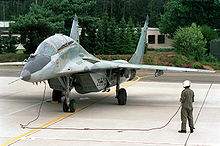 A MiG 29 of the Luftwaffe
A MiG 29 of the Luftwaffe
Since the early 1990s the Bundeswehr has become more and more engaged in international operations in and around the former Yugoslavia, and also in other parts of the world like Cambodia or Somalia. After the September 11, 2001 attacks, German forces were employed in most related theaters except Iraq.
Currently (February 7, 2011) there are Bundeswehr forces in:
 Afghanistan
Afghanistan
 Kosovo
Kosovo
 Bosnia and Herzegovina
Bosnia and Herzegovina
- EUFOR (former SFOR)
- 110 personnel[11]
- (mandate limit: 2,400)
- since 2 December 2004 under European Union Command
- Horn of Africa/Indian Ocean
- Operation Enduring Freedom
- Operation Atalanta
- 295 personnel[11]
- (mandate limit 2,800 personnel)
 Sudan
Sudan
- UNMIS
- 30 personnel[11]
- (no mandate limit)
 Lebanon
Lebanon
- ATALANTA
- 295 personnel[11]
The actual number of troops serving in an abroad deployment complies with the requirements of the current security situation. In addition to the numbers above, forty soldiers are on permanent stand-by for medical evacuation operations around the world in assistance of ongoing German or coalition operations (STRATAIRMEDEVAC).
In support of Allied stabilization efforts in Iraq, the Bundeswehr is also training the new Iraqi forces in locations outside Iraq, such as the United Arab Emirates and Germany.
Since 1994, the Bundeswehr has lost about 100 troops in deployments abroad. See also: German Armed Forces casualties in Afghanistan.
Equipment
Further information: Standard Light Weapons of the German Army, Aircraft Inventory of the German Luftwaffe and Vessels of the German Navy A PzH 2000 howitzer of the German Army
A PzH 2000 howitzer of the German Army
According to the new threat scenario facing Germany and its NATO allies, the Bundeswehr is currently reorganising itself. To realise growth in mobility and the enlargement of the air force's capabilities, the Bundeswehr is going to buy 60 Airbus A400M transports as well as 180 Eurofighter Typhoon fighters and also several unmanned aerial vehicle models. For the ground forces it is currently developing a land soldier system and a new generation of transportation vehicles and light vehicles, such as the Fennek, the Boxer MRAV, KMW Grizzly, or the Puma (IFV). Further, the German Navy is going to build new corvettes (dubbed K131), the new F125 class frigates, two Joint Support Ships and two more Type 212 submarines.
Appearance
Uniforms
The service uniform is theoretically the standard type of Bundeswehr uniform for general duty and off-post activity, most associated, however, with ceremonial occasions. The army's service uniform consists of a light gray, single-breasted coat and darker gray trousers, worn with a light blue shirt, black tie, and black shoes. The peaked, visored cap has been replaced by the beret as the most common form of headgear. Dress uniforms featuring dinner jackets or double-breasted coats are worn by officers for various social occasions. The battle and work uniform consists of Flecktarn camouflage fatigues, which are also worn on field duty. In practice, they are also used for general duty and off-post at least at barracks where there is also field duty even by others, and for the way home or to the post, and generally regarded as the Heer uniform.[13] In all three services, light sand-colored uniforms are available for duty in warmer climates.
A different, traditional variety of the service uniform is worm by the Gebirgsjäger (mountain infantry), consisting of ski jacket, stretch trousers, and ski boots. Instead of the beret, they wear the grey "mountain cap". (see here for details.) The field uniform is the same, except for the (optional) metal Edelweiss worn on the forage cap.
The traditional arm-of-service colors appear as lapel facings and as piping on shoulder straps. Generals wear an inner piping of gold braid; other officers wear silver piping. Lapel facings and piping are maroon for general staff, green for infantry, red for artillery, pink for armor, black for engineers, yellow for communications, dark yellow for reconnaissance and various other colors for the remaining branches. Combat troops wear green (infantry), black (armor), or maroon (airborne) berets. Logistics troops and combat support troops, such as artillery or engineers, wear red berets. A gold or silver badge on the beret denotes the individual branch of service.
The naval forces wear the traditional navy blue, double-breasted coat and trousers; enlisted personnel wear either a white shirt or a navy blue shirt with the traditional navy collar. White uniforms provide an alternative for summer. The officer's dress cap is mounted with a gold anchor surrounded by a wreath. The visor of the admiral's cap bears a double row of oak leaves.
The air force service uniform consists of a blue jacket and trousers with a light blue shirt, dark blue tie, and black shoes. Olive battle dress similar to the army fatigue uniform is worn in basic training and during other field duty. Flying personnel wear wings on their right breast. Other air force personnel wear a modified wing device with a symbol in its center denoting service specialization. These Tätigkeitsabzeichen come in bronze, silver, or gold, depending on one's length of service in the specialty. Wings, superimposed over a wreath, in gold, silver, or bronze, depending on rank, are also worn on the service or field cap.
Ranks
In general, officer ranks are those used in the Prussian and pre-1945 German armies. Officer rank insignia are worn on shoulder straps or shoulder boards. Army (Heer) and air force (Luftwaffe) junior officers' insignia are four pointed silver stars while field grade officers wear silver (black or white on camouflage uniforms) stars and an oak wreath around the lowest star. The stars and wreath are gold for general officers. In the case of naval (Marine) officers, rank is indicated by gold stripes on the lower sleeve of the blue service jacket and on shoulder boards of the white uniform.
Soldier and NCO ranks are similar to those of the Prussian and pre-1945 German armies. In the army and air force, a Gefreiter corresponds to the NATO rank OR-2 and Hauptgefreiter to OR-3. An Unteroffizier is the lowest-ranking sergeant (OR-5), followed by Stabsunteroffizier (OR-6), Feldwebel and Oberfeldwebel (OR-7), Hauptfeldwebel (OR-8), Stabsfeldwebel (OR-9) and Oberstabsfeldwebel. Ranks of army and air force enlisted personnel are designated by stripes, chevrons, and "sword knots" worn on rank slides. Naval enlisted rank designations are worn on the upper (OR 1-5) or lower (OR-6 and above) sleeve along with a symbol based on an anchor for the service specialization (rating). Army and air force officer candidates hold the separate ranks of Fahnenjunker, Fähnrich and Oberfähnrich, and wear the appropriate rank insignia plus a silver cord bound around it. Officers candidates in the navy Seekadett (sea cadet; equivalent to OR-4) and Fähnrich zur See (midshipman second class; OR-5) wear the rank insignia of the respective enlisted ranks but with a gold star instead of the rating symbol, while an Oberfähnrich zur See (midshipman first class; OR-7) wears an officer type thin rank stripe.
Medical personnel of all three services wear a version of the traditional caduceus (staff with entwined serpents) on their shoulder straps or sleeve. The officers' ranks have own designations differing from the line officers, the rank insignias however are basically the same.
Traditions
Former German military organisations have been the old German state armies, the Reichswehr (1921–1935) and the Wehrmacht (1935–1945). The Bundeswehr, however, does not consider itself as their successor and does not follow the traditions of any former German military organisation. The official Bundeswehr traditions are based on three major lines:[14]
- the military reformers at the beginning of the 19th century such as Scharnhorst, Gneisenau, and Clausewitz
- the members of the military resistance against Hitler such as Claus von Stauffenberg and Henning von Tresckow
- its own tradition since 1955
As its symbol the Bundeswehr uses a form of the Iron Cross. The Iron Cross has a long history, having been awarded as a military wartime decoration for all ranks since 1813, and earlier associated with the Teutonic knights. The name Bundeswehr was proposed by the former Wehrmacht general and liberal politician Hasso von Manteuffel.
One of the most visible traditions is the Großer Zapfenstreich, a form of military tattoo that goes back to the landsknecht era.[citation needed] Another expression of the traditions in the German armed forces is the ceremonial vow (Gelöbnis) of recruits, during basic training. Annually on July 20, the date of the assassination attempt on Adolf Hitler by Wehrmacht officers in 1944, recruits of the Wachbataillon vow at the Bendlerblock, where the officers had their headquarters. The wording of the ceremonial vow of conscripts was and still is (for full time recruits and volunteer personnel starting from 2011):
- "I pledge to loyally serve the Federal Republic of Germany and to bravely defend the right and the freedom of the German people."
- "Ich gelobe, der Bundesrepublik Deutschland treu zu dienen und das Recht und die Freiheit des deutschen Volkes tapfer zu verteidigen."
Professional soldiers and officers of the Bundeswehr have to swear an oath with the same words, but beginning with "Ich schwöre, ..." ("I vow to...").
Rank structure and superior-subordinate relations
- Bundeswehr rank insignia
- Command and obedience in the Bundeswehr
Ranks of the Army and Air Force
Enlisted
- Schütze/Flieger or equivalent rank - Private/Airman Basic/Aircraftman or equivalent rank
- Gefreiter - Private/Airman E2
- Gefreiter-UA - Private/Airman E2 - NCO Candidate (Sergeants/Staff Sergeants)
- Gefreiter-FA - Private/Airman E2 - NCO Candidate (Staff Sergeant/Flight Sgts.)
- Gefreiter-OA - Private/Airman E2 - Officer Candidate
- Obergefreiter - Private First Class / Airman First Class
- Hauptgefreiter - Lance Corporal / Senior Airman
- Stabsgefreiter - Corporal
- Oberstabsgefreiter - Specialist / Lance-Sergeant/ Master Corporal
Non-commissioned officers
- Unteroffizer - Junior Sergeant
- Unteroffizer-UA - Junior Sergeant - Candidate Staff Sergeant
- Stabsunteroffizer - Sergeant
- Feldwebel - Staff Sergeant / Flight Sergeant
- Oberfeldwebel - Sergeant First Class / Technical Sergeant
- Hauptfeldwebel - Master Sergeant
- Stabsfeldwebel - First Sergeant / Quartermaster Sergeant/ Senior Master Sergeant
- Oberstabsfeldwebel - Sergeant Major
Officer Cadets
- Fahnenjunker- Cadet / Officer Candidate (with the rank of Unteroffizier)
- Fähnrich - Ensign (with the rank of Feldwebel)
- Oberfähnrich - Senior Ensign (with the rank of Hauptfeldwebel)
Officers
- Leutnant - 2nd Lieutenant
- Oberleutnant - 1st Lieutenant/Lieutenant
- Hauptmann - Captain (land and air)
- Stabshauptmann - Senior Captain
- Major
- Oberstleutnant - Lieutenant Colonel
- Oberst - Colonel
- Brigadegeneral - Brigadier General/Brigadier
- Generalmajor - Major General
- Generalleutnant - Lieutenant General
- General
Enlisted
- Matrose - Seaman Recruit
- Gefreiter - Seaman Apprentice E2
- Gefreiter-UA - Seaman Apprentice E2 - Petty Officer Candidate
- Gefreiter-BA - Seaman Apprentice E2 - Chief Petty Officer Candidate
- Gefreiter-OA - Seaman Apprentice E2 - Officer Candidate
- Obergefreiter - Seaman
- Hauptgefreiter - Ordinary Seaman
- Stabsgefreiter - Able Seaman
- Oberstabsgefreiter - Leading Seaman
Non-commisioned officers
- Maat - Petty Officer 3rd Class
- Maat-BA - Petty Officer 3rd Class - Probationary Chief Petty Officer
- Obermaat - Petty Officer 2nd Class
- Bootsmann - Petty Officer 1st Class
- Oberbootsmann - Chief Petty Officer
- Hauptbootsmann - Senior Chief Petty Officer
- Stabsbootsmann - Master Chief Petty Officer
- Oberstabsbootsmann - Command Master Chief Petty Officer, Fleet/Force Master Chief Petty Officer
Officer cadets
- Seekadett - Sea Cadet
- Fähnrich zur See - Midshipman 2nd class in the rank of Petty Officer 1st Class
- Oberfähnrich zur See - Midshipman 1st class in the rank of Senior Chief Petty Officer
Officers
- Leutnant zur See - Ensign
- Oberleutnant zur See - Lieutenant (junior grade) / Sublieutenant
- Kapitänleutnant - Lieutenant
- Stabskapitänleutnant - Senior Lieutenant
- Korvettenkapitän - Lieutenant Commander
- Fregattenkapitän - Commander
- Kapitän zur See - Sea Captain (naval)
- Flottillenadmiral - Flotilla Admiral
- Konteradmiral - Counter Admiral, Rear Admiral
- Vizeadmiral - Vice Admiral
- Admiral
Awards
See also Awards and decorations of the German Armed Forces
- Bundesverdienstkreuz, the Order of Merit Cross of the German Federal Republic
- Badge of Honour of the Bundeswehr
- Combat Action Medal of the Bundeswehr
- German Armed Forces Service Medal
- German Armed Forces Flood Service Medal
- German Armed Forces Badge for Military Proficiency
- German Armed Forces Badge of Marksmanship
- German Parachutist Badge
- German Sports Badge
See also
References
- ^ "Art 65a Basic Law". Gesetze-im-internet.de. http://www.gesetze-im-internet.de/englisch_gg/englisch_gg.html#GGengl_000P65a. Retrieved 2011-06-07.
- ^ "Art 115b Basic Law". Gesetze-im-internet.de. http://www.gesetze-im-internet.de/englisch_gg/englisch_gg.html#GGengl_000P115b. Retrieved 2011-06-07.
- ^ "Art 87a (1) Basic Law". Gesetze-im-internet.de. http://www.gesetze-im-internet.de/englisch_gg/englisch_gg.html#GGengl_000P87a. Retrieved 2011-06-07.
- ^ "Germany: Refusing to Bear Arms 2005 revision". Wri-irg.org. http://www.wri-irg.org/co/rtba/germany.htm. Retrieved 2011-06-07.
- ^ [1]
- ^ Fritz Erler, ‘Politik und nicht Prestige,’ in Erler and Jaeger, Sicherheit und Rustung, 1962, p.82-3, cited in Julian Lider, Origins and Development of West German Military Thought, Vol. I, 1949-1966, Gower Publishing Company Ltd, Aldershot/Brookfield VT, 1986, p.125
- ^ Aberheim, ‘The Citizen in Uniform: Reform and its Critics in the Bundeswehr,’ in Szabo, (ed.), The Bundeswehr and Western Security, St. Martin’s Press, New York, 1990, p.39.
- ^ Donald Aberheim, 1990, p.37; Donald Aberheim, ‘German Soldiers and German Unity: Political Foundations of the German Armed Forces,’ California Naval Postgraduate School, 1991, p.14, cited in Artur A Bogowicz, ‘Polish Armed Forces of 2000: Demands and Changes,’ NPGS Thesis, March 2000, available via http://oai.dtic.mil/oai/oai?verb=getRecord&metadataPrefix=html&identifier=ADA376462 and Obituary for General Ulrich de Maizière, The Times, September 13, 2006 via http://www.timesonline.co.uk/tol/comment/obituaries/article636707.ece.
- ^ Large, David Clay Germans to the Front West German rearmament in the Adenauer era University of North Carolina Press 1996 pp244-5 ISBN 0-8078-4539-6
- ^ Large op.cit. pp263-4
- ^ a b c d e f g 28 Jan 2011 Web.07 Feb 2011. <http://www.bundeswehr.de/portal/a/bwde/kcxml/04_Sj9SPykssy0xPLMnMz0vM0Y_QjzKLd443DgoESYGZASH6kTCxoJRUfV-P_NxUfW_9AP2C3IhyR0dFRQD-G0VU/delta/base64xml/L3dJdyEvd0ZNQUFzQUMvNElVRS82X0NfNDJE>.
- ^ "Bundeswehr-Einsatz in Afghanistan: Kabinett beschließt Aufstockung der Truppen - Politik" (in (German)). Bild.de. 2010-02-09. http://www.bild.de/BILD/politik/2010/02/09/bundeswehr-einsatz-in-afghanistan/kabinett-beschliesst-aufstockung-der-truppen.html. Retrieved 2011-06-07.
- ^ A soldier's joke about this situation runs thus: “The service uniform is called service uniform because it's not worn on service, while the field uniform is called field uniform because it's not worn in the field.” (In the field they wear the battle uniform (“Gefechtsanzug”), an extended version of the field uniform.)
- ^ "Traditionen der Bundeswehr" (in German). Bundesministerium der Verteidigung. http://www.bundeswehr.de/portal/a/bwde/kcxml/04_Sj9SPykssy0xPLMnMz0vM0Y_QjzKLd443cXQESYGYxgEh-pEwsaCUVH1fj_zcVH1v_QD9gtyIckdHRUUAWBsN8w!!/delta/base64xml/L3dJdyEvd0ZNQUFzQUMvNElVRS82X0NfNEVI. Retrieved 2008-08-06.
External links
- Bundeswehr – Official site (in German)
- Federal Ministry of Defence official site (in German, English and French)
- Bundesamt für Wehrtechnik und Beschaffung official site (in German)
- Bundesamt für Informationsmanagement und Informationstechnik der Bundeswehr official site (in German)
- Territoriale Wehrverwaltung official site (in German)
- [http://www.y-magazin.de/ Y - Magazine of the Federal Defence Forces (in German)
- [http://www.if-zeitschrift.de/ Zeitschrift fuer Innere Fuehrung (in German)
- [http://www.readersipo.de/ Reader Sicherheitspolitik (in German)
 Military of Germany (Bundeswehr)
Military of Germany (Bundeswehr)North Atlantic Treaty Organization (NATO) History 
Structure Members Militaries of the member states of the European Union Military of Europe Sovereign
states- Albania
- Andorra
- Armenia
- Austria
- Azerbaijan
- Belarus
- Belgium
- Bosnia and Herzegovina
- Bulgaria
- Croatia
- Cyprus
- Czech Republic
- Denmark
- Estonia
- Finland
- France
- Georgia
- Germany
- Greece
- Hungary
- Iceland
- Ireland
- Italy
- Kazakhstan
- Latvia
- Liechtenstein
- Lithuania
- Luxembourg
- Macedonia
- Malta
- Moldova
- Monaco
- Montenegro
- Netherlands
- Norway
- Poland
- Portugal
- Romania
- Russia
- San Marino
- Serbia
- Slovakia
- Slovenia
- Spain
- Sweden
- Switzerland
- Turkey
- Ukraine
- United Kingdom
- Vatican City
States with limited
recognition- Abkhazia
- Kosovo
- Nagorno-Karabakh
- Northern Cyprus
- South Ossetia
- Transnistria
Other entities - European Union
- Sovereign Military Order of Malta
Categories:- Bundeswehr
- Armies by country
- Conscript militaries
- Military history of Germany
- Military of Germany
- 1955 establishments in West Germany
- 1955 in West Germany
Wikimedia Foundation. 2010.

